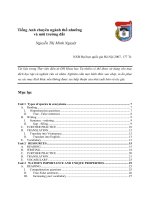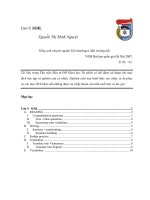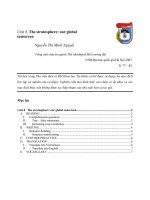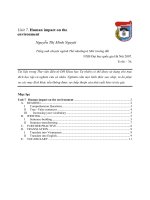Tiếng anh chuyên ngành Thổ nhưỡng và Môi trường đất phần 4 docx
Bạn đang xem bản rút gọn của tài liệu. Xem và tải ngay bản đầy đủ của tài liệu tại đây (201.06 KB, 12 trang )
Tiếng anh chuyên ngành Thổ nhưỡngvà Môi trường đất
NXB Đại học quốc gia Hà Nội 2007.
Tr 34 – 43.
Tài liệu trong Thư viện điện tử ĐH Khoa học Tự nhiên có thể được sử dụng cho mục đích
học tập và nghiên cứu cá nhân. Nghiêm cấm mọi hình thức sao chép, in ấn phục vụ các
mục đích khác nếu không được sự chấp thuận của nhà xuất bản và tác giả.
Mục lục
Unit 4 POLLUTION 2
A. READING 2
I. Comprehension questions 3
II. True - False sentences 4
III. Increasing your vocabulary 5
B. Writing 6
I. Sentence-building 6
II. Sentence-transforming 7
C. Further practice 8
Exercise 2: Phrasal verb 8
Substitute the underlined verbs with one of the phrasal verbs below. 8
D. Translation 9
I. Translate into Vietnamese 9
II. Translate into English 10
E. Vocabulary 11
Unit 4. POLLUTION
Nguyễn Thị Minh Nguyệt
Unit 4
POLLUTION
A. READING
a. Warm-up Activities
- What do you think about our living environment at the moment?
- Is it polluted daily?
What is pollution? Any addition to air, water, soil or food that threatens the health, survival
capability, or activities of humans or other living organisms is called pollution. Most pollutants
are solid, liquid, or gaseous by-products or wastes produced when a resource is extracted,
processed, made into products, or used. Pollution can also take the form of unwanted energy
emissions such as excessive heat, noise, or radiation.
A major problem is that people differ on whether something is a pollutant and on acceptable
levels of pollution, especially if they have to choose between pollution control and their jobs.
Sources: Pollutants can enter the environment naturally (for example, from volcanic
eruptions) or through human activities (for example, from burning coal). Most natural pollution is
dispersed over a large area and diluted or broken down to harmless levels by natural processes.
By contrast, most serious pollution from human activities occurs in or near urban and industrial
areas, where pollutants are concentrated in small volumes of air, water, and soil. Industrialized
agriculture is also a major source of pollution.
Some pollutants contaminate the areas where they are produced. Other are carried by
wind or flowing water to other areas. Pollution does not respect state or natural boundaries.
SOME POLLUTANTS COME FROM SINGLE, IDENTIFIABLE SOURCES, SUCH AS
THE SMOKESTACK OF A POWER PLANT, THE DRAINPIPE OF A MEAT-PACKING
PLANT, THE CHIMNEY OF A HOUSE, OR THE EXHAUST PIPE OF AN AUTOMOBILE.
THESE ARE CALLED POINT SOURCES. OTHER POLLUTANTS ENTER THE AIR,
WATER, OR SOIL FROM DISPERSED, AND OFTEN HARD TO IDENTIFY NON-POINT
SOURCES. EXAMPLES ARE THE RUNOFF OF FERTILIZERS AND PESTICIDES (FROM
FARMLANDS AND SUBURBAN LAWNS AND GARDENS) INTO STREAMS AND
LAKES, AND PESTICIDES SPRAYED INTO THE AIR OR BLOWN BY THE WIND INTO
THE ATMOSPHERE. IT IS MUCH EASIER AND CHEAPER TO IDENTIFY AND
CONTROL POLLUTION FROM POINT SOURCES THAN FROM WIDELY DISPERSED
NON-POINT SOURCES.
Effects: Unwanted effects of pollutants are (1) disruption of life-support systems for us and
other species; (2) damage to wildlife; (3) damage to human health; (4) damage to property; and
(5) nuisance effects such as noise and unpleasant smells, tastes and sights.
Three factors determine how severe the effects of pollutants will be. One is its chemical
nature-how active and harmful it is to living organisms. Another is its concentration-the amount
per volume unit of air, water, soil, or body weight. One way to lower concentration of a pollutant
is to dilute it in a large volume of air or water. Until we started overwhelming the air and
waterways with pollutants, dilution was the solution. Now it is only a partial solution.
A third factor is a pollutant's persistence-how long it stays in the air, water, soil, or body.
Degradable, or non-persistent, pollutants are broken down completely or reduced to acceptable
levels by natural physical, chemical, and biological processes. Those broken down by living
organisms (usually by specialized bacteria) are called biodegradable pollutants. Human sewage in
a river, for example, is biodegraded fairly quickly by bacteria if it is not added faster than it can
be broken down.
Unfortunately, many of the substances we introduce into the environment take decades or
longer to degrade. Examples of these slowly degradable or persistent pollutants include the
insecticide DDT; most plastics, aluminium cans, and clorofluorocacbons (CFC
s
)-these latter used
as coolants in refrigerators and air conditioners, as spray propellants (in some countries), and as
foaming agents for making some plastics.
Non-degradable pollutants cannot be broken down by natural processes. Examples include
the toxic elements lead and mercury. The best ways to deal with non-degradable pollutants are to
not release them into the environment, to recycle them, or to remove, them from contaminated
air, water or soil (an expensive process).
We can know little about the possible harmful effects of 80% of the 70,000 synthetic
chemicals now in commercial use. Our knowledge about the effects of the 20% of these
chemicals is limited, mostly because it is quite difficult, time-consuming, and expensive to get
this knowledge.
(Taken from "Sustaining the Earth " by Tyler Miller, G)
I. Comprehension questions
Answer the following sentences
1. Give a definition of pollution?
2. What are forms of pollutants? When are the wastes produced?
3. How can pollutants go into the environment?
4. Where does the most serious pollution from human activities happen?
5. How do the pollutants pollute the environment?
6. What are point sources and non-point sources?
7. What are the factors determining how severe the effects of a pollutant will be?
8. What does those in "Those broken down by living organisms " refer to?.
9. How long do the substances degrade?
10. What does "these" in "these latter used as coolants in refrigerators " refer to?
II. True - False sentences
Decide whether the following statements are true "T" or false "F". Correct the
false statements.
1. Only activities of human beings pollute the environment.
2. Pollutants exist in many forms but solid.
3. Some pollutants come from a power plant and a meat-packing one and
some others from the chimney of a house and the exhaust pipe of an
automobile as well.
4. It's not easy to identify the pollutants going into the air, water or soil from
dispersed sources.
5. Controlling pollution from non-point sources is easier and cheaper than
from point sources.
6. The text mentions more than five unwanted effects of pollutants.
7. A pollutant's persistence means the time a pollutant stays in the air, water,
soil or body.
8. Degradable pollutants and non-degradable ones can be broken down by
natural processes.
9. Recycling non-degradable pollutants is one of the best ways to deal with
them.
10. Iron, copper and aluminum are all energy resources.
III. Increasing your vocabulary
11. Antonyms
Which words or phrases in a, b, c or d have opposite meaning to survive:
a. continue to live.
b. exist in spite of a danger, an accident, etc
c. remain alive.
d. cease to live.
12. Synonyms
Look at the text again and say which words or phrases have the same meaning as:
1. go into
2. contamination
3. existing by nature
4. happen
5. substances that pollute the environment
6. continue in existence
7. can be identified
8. to be taken out
9. scatter widely
10. incidental products
13. Word-form
Use your dictionary to complete the table with the appropriate forms of the given words in
the text. The first is done as an example.
Noun Verb Adjective Adverb
1. beauty beautify beautiful beautifully
2. addition
3. threaten
4. capability
5. pollution
6. differ
7. acceptable
8. activity
9. industrial
10. identifiable
B. Writing
I. Sentence-building
Make necessary changes and additions to complete the following passage from
the prompts given below:
1. Pollution / mean / contamination / fresh water / which / decrease / its purity / and / often / make
/ it / unsuitable / water resource use.
2. Pollution / also / damage / aquatic habitats / the plants / animals / live / within / them.
3. We / tend / think / pollutants / being poisonous.
4. Some pollutants / be / highly toxic.
5. Whereas / many / be / only / a problem / when / they / accumulate / critical concentrations.
6. Many organic pollutants / cause / oxygen depletion / lakes / rivers.
7. When / this / happen / aquatic ecosystem / be / alter.
II. Sentence-transforming
Finish each of the following sentences in such a way that it mean the same as the
sentence printed before it.
1. Any addition to air, water, soil threatening the health, survival capability, or activities of
humans or other living organisms is called pollution.
Any addition to air, water, soil that
2. Most natural pollution is dispersed or broken down by natural processes.
Natural processes
3. Industrialized agriculture is a major cause of pollution.
A major cause of pollution
4. Most serious pollution from human activities occurs in or near urban and industrial areas.
Urban and industrial areas
5. Some pollutants are carried by wind or flowing water to other areas.
Wind or flowing water
6. Some pollutants come from single, identifiable sources.
Some pollutants are
7. It's quite difficult, time-consuming, and expensive to get knowledge of synthetic chemicals.
To get
C. Further practice
Exercise 1: Gap-filling: Read the following passage and fill in each gap with a suitable word
The atmosphere is filled with everything that is light enough to be carried by the wind. Much
(1) this pollution happens naturally as a (2) of dust storms, forest fires, and volcanic
eruptions. But in recent years, human (3) have increased the atmosphere’s burden of
pollutants. As populations around the world (4) grown, waste products from industry and
agriculture have poured into (5) skies. Engines and furnaces burning oil, coal, and natural
gas, the so-called fossil (6) , release a wide variety of pollutants. Chemical compounds
(7) as chlorofluorocarbon in refrigerators and aerosol sprays, not (8) pollute but
also destroy the atmosphere’s ozone (9) . Smoke from factories is usually reminder
(10) the damage done to the planet’s atmosphere.
Exercise 2:
Phrasal verb
Substitute the underlined verbs with one of the phrasal verbs below.
bring up die out get rid of carry on
turn up use up look into turn into
go ahead with turn down break down consist of
1. Pollution is destroying the environment.
2 I am sorry to mention this, Sue, but I think that Peter is seeing
another woman.
3. The company was told that it could begin the construction of a new
plant.
4. If nation continue to dump nuclear waste at sea, the oceans will
become poisoned.
5. The council has refused
the request to build another car park.
6. Solar energy includes the production of electricity and heat directly
from solar radiation for many applications.
7. The rhinoceros will become extinct
if people continue to hunt it.
8. Government officials are investigating reports that the lake is being
polluted by a chemical factory.
9. When sulphur dioxide mixes with other elements, it becomes acid
rain.
10. Oil, coal and gas are being consumed so quickly that supplies will
shortly be finished.
11. Factory bosses should think carefully about where they throw away
waste.
12. When they arrived at the demonstration, it had already finished.
(Taken from "Think First Certificate" by Jonauntion, R)
D. Translation
I. Translate into Vietnamese
There are many different sources of pollution and they vary from place to place and through
the time. Some are point sources-specific places such as factories and mines which release
contaminated water. Much pollution come from diffuse or non-point sources, of which
agriculture is the most widespread. Agriculture causes water pollution in a variety of ways,
including the leaching of nitrate (from fertilizers), and the accumulation of pesticides and other
contaminants. Most water pollution problem arises from the continuous or intermittent
contaminants into streams, lake, rivers, and groundwater. From time to time there are major
pollution incidents in particular places, which create problems because they are usually
unexpected but can spread pollution across wide areas.
(Taken from "Environmental Sciences" by Wilson, R)
II. Translate into English
1. Hiện nay khói trong khí quyển nhiều đến mức mà lượng ánh sáng mặt trời ở một số thành
phố trên thế giới đã giảm xuống một cách đáng kể.
2. Sự ô nhiễm không khí là một trong những nguyên nhân làm con người bị bệnh. ở nhiều nước
đã có luật hạn chế lượng khói mà các nhà máy thải ra. Mặc dù chưa có đầy đủ thông tin về
những tác hại của khói trong khí quyển, các bác sỹ đã chứng minh rằng sự ô nhiễm không khí
gây bệnh ung thư phổi.
3. Ngày nay việc thải lưu huỳnh điôxit từ các trạm điện vẫn đang tiếp tục tăng lên. Đó là một
trong những nguyên nhân gây ra mưa axit. Các chất gây ô nhiễm khác là cacbon điôxit (CO2)
và cacbon ôxit (CO). Cacbon ôxit (CO) phần lớn do xe gắn máy gây ra và nó có ảnh hưởng
đến sức khoẻ của trẻ em. Cacbon điôxit (CO2) thì ít nguy hiểm nhất trong số các chất ô
nhiễm đã nói ở trên nhưng trong thời gian lâu hơn thì nó có thể là chất gây hại nhất.
4. Sự suy giảm tầng ôzôn do các hoạt động của con người gây ra là nguyên nhân tác động đến
sức khoẻ của con người và môi trường. Khí thải công nghiệp, khí thải của các phương tiện
giao thông có động cơ, khí thoát ra từ các quá trình sinh học là các nguồn chủ yếu gây ô
nhiễm không khí.
E. Vocabulary
1. aerosol (n) : một loại chất có trong các bình xịt
2. atmosphere (n) : khí quyển
3. bacteria (n) : vi khuẩn
4. boundary (n) : đường biên giới
5. chemical compound (n) : hợp chất hoá học
6. coal (n) : than đá
7. concentrate (v) : tập trung
8. contaminate (v) : làm nhễm bẩn, gây ô nhiễm
9. degrade (v) : làm suy thoái, suy giảm
10. differ (v) : khác, không giống
11. enter (v) : đi vào, thâm nhập
12. erupt (v) : phun trào
13. exhaust (v) : hết, cạn kiệt
14. fertilizer (n) : phân bón
15. furnaces (n) : lò luyện kim
16. identify (v) : nhận ra
17. industrialize (v) : công nghiệp hoá
18. insecticide (n) : thuốc diệt côn trùng
19. lead (n) : chì
20. major (adj) : chính, chủ yếu
21. mercury (n) : thuỷ ngân
22. organism (n) : sinh vật
23. overwhelm (v) : làm tràn ngập, áp đảo, lấn áp
24. pesticide (n) : thuốc trừ sâu
25. radiation (n) : sự phóng xạ
26. respect (v) : tôn trọng
27. sewage (n) : nước cống
28. spray (v) : phun, xịt
29. substance (n) : chất
30. volcanic eruption (n) : sự phun trào núi lửa









